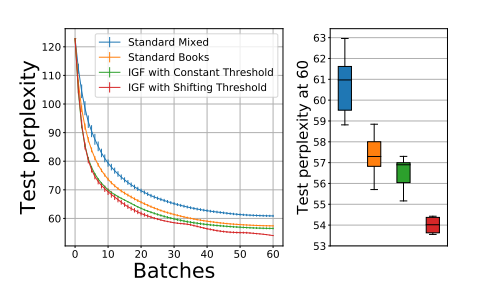Spaces:
Paused
Information Gain Filtration(IGF)
Authors @Tuko @mraunak
This folder contains the code how to implement IGF for finetuning on GPT-2.
What is IGF?
Here we present a general fine-tuning method that we call information gain filtration for improving the overall training efficiency and final performance of language model fine-tuning(see paper below). The method is an alternative fine-tuning method that trains a secondary model (e.g., a simple convolutional network) to predict the amount of information gained over a given pre-trained model. The secondary model is lightweight and trained to predict the Information Gain measure. Information Gain is defined as the change in a loss function for a model before and after an SGD update with a sample (Equation X in the paper). A small subset of the training set named the “objective” set, is used to measure information gain on the pre-trained model, and consequently to train the secondary model. After training, the model is used for filtering samples for the fine-tuning process. Therefore, a high information gain value would suggest a sample is informative, whereas a low value would suggest a non-informative sample that should be filtered out. Thus, a thresholding strategy is defined to select informative samples. With such a strategy, samples are filtered and once enough samples are selected to form a mini-batch and a usual fine-tuning/optimization step is applied. The filtration process is repeated until the fine-tuning process is over.
Paper Selecting Informative Contexts Improves Language Model Finetuning
Results
Several experiments were conducted to show the robustness of the IGF method versus the standard fine-tuning process. For example, we achieve a median perplexity of 54.0 on the Books dataset compared to 57.3 for standard fine-tuning on GPT-2 Small. The code was implemented using the Transformers library and Pytorch. While the method may seem more expensive, we saw enough evidence that it may lead to a performance benefit in the final models.
Figure 1: Comparing IGF to Standard Fine-tuning: IGF with constant (p < 10−3 , t-test) and shifting(p < 10−6 , t-test) thresholding significantly outperform standard fine-tuning. The left-hand figure shows test-set perplexity after each fine-tuning batch, averaged over 50 runs (error bars denote ± one standard error). The right-hand figure shows the perplexity of each method after 60 batches. IGF with shifting thresholding (red) clearly improves over standard batched fine-tuning with Adam
How to use this project?
To fine-tune a transformer model with IGF on a language modeling task, use the following script:
model_name_or_path: Path to pretrained model or model identifier from huggingface.co/modelsdata_file: A jbl file containing tokenized data which can be split as objective dataset, train_dataset and test_datasetigf_data_file: A jbl file containing the context and information gain pairs to train secondary learner.context_len: The maximum total input sequence length after tokenization. Sequences longer than this will be truncated, sequences shorter will be padded.size_objective_set: Number of articles that are long enough to be used as our objective set"min_len: The minimum length of the article to be used as objective settrim: Truncate the example if it exceeds context lengtheval_freq: Secondary model evaluation can be triggered at eval_freqmax_steps: To calculate training epochsnumber: The number of examples split to be used as objective_set/test_datasecondary_learner_batch_size: The batch size of training data for secondary learnersecondary_learner_max_epochs: The number of epochs to train secondary learnerrecopy_model: Reset the model to the original pretrained GPT-2 weights after each iterationeval_interval: Decay the selectivity of our secondary learner filter from" 1 standard deviation above average to 1 below average after eval_interval(10) batches"
python run_clm_igf.py\
--model_name_or_path "gpt2" \
--data_file="data/tokenized_stories_train_wikitext103" \
--igf_data_file="data/IGF_values" \
--context_len 32 \
--size_objective_set 100 \
--min_len 1026 \
--trim True \
--eval_freq 100 \
--max_steps 1000 \
--secondary_learner_batch_size 128 \
--secondary_learner_max_epochs 15 \
--number 100 \
--recopy_model \
--eval_interval 10 \
Citation
If you find the resource useful, please cite the following paper
@inproceedings{antonello-etal-2021-selecting,
title = "Selecting Informative Contexts Improves Language Model Fine-tuning",
author = "Antonello, Richard and Beckage, Nicole and Turek, Javier and Huth, Alexander",
booktitle = "Proceedings of the 59th Annual Meeting of the Association for Computational Linguistics and the 11th International Joint Conference on Natural Language Processing (Volume 1: Long Papers)",
month = aug,
year = "2021",
address = "Online",
publisher = "Association for Computational Linguistics",
url = "https://aclanthology.org/2021.acl-long.87",
doi = "10.18653/v1/2021.acl-long.87",
pages = "1072--1085",
}
